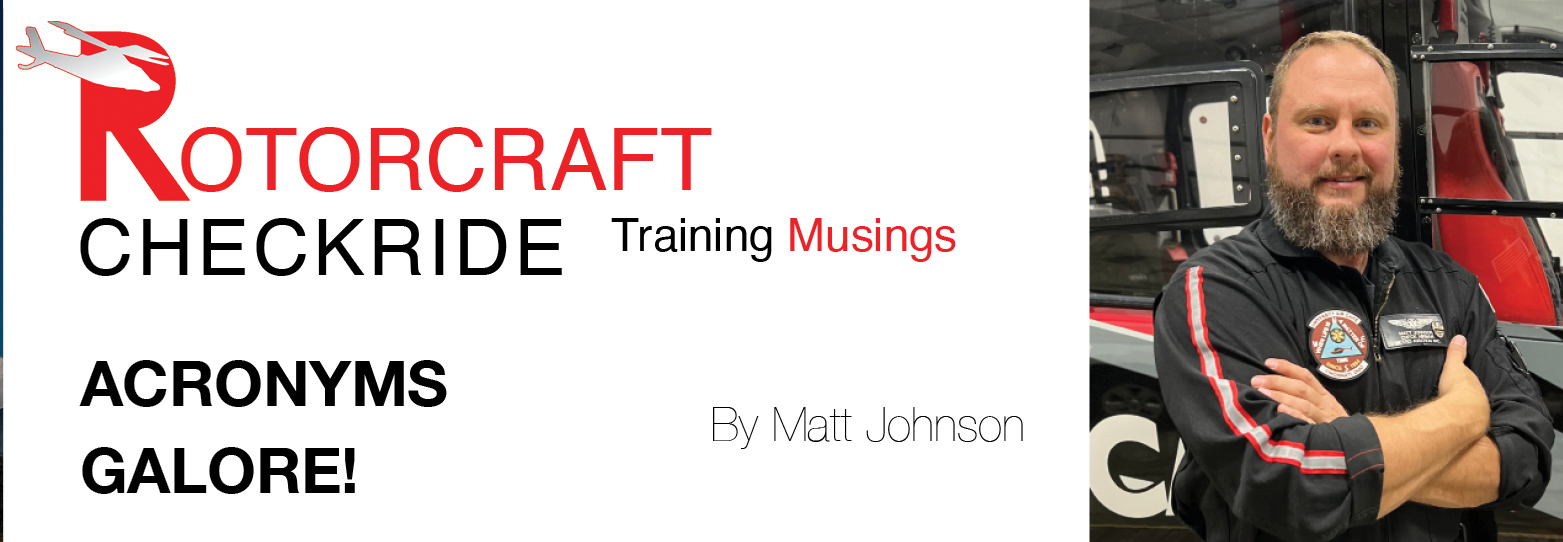|
Jul
07
2025
|
|
Posted 188 days ago ago by Admin
|
|

In over a decade as a Designated Pilot Evaluator, I've realized three things are guaranteed to occur at every practical exam. One is the given: nervousness. The second is that the applicant will invariably forget their IACRA password (okay, I’m being a bit facetious). The third is the barrage of acronyms that will be used during the exam. Don’t get me wrong, I’m not an acronym hater; they have their place. I may find myself in four to five different aircraft models in a given week, and I routinely use acronyms to help me not do something stupid.
The use of the word "acronym" has grown exponentially since the 1950s. Presumably, aviation training is one of many reasons for the ubiquitous nature of acronyms.
An acronym is merely an abbreviation formed from the initial letters of other words and pronounced as a word. Anyone with a pilot certificate at the student pilot level or higher has invariably been inundated with these various "study aids" during their training. Essentially, an acronym is a form of a mnemonic. A mnemonic is traditionally a pattern of letters, ideas, or associations that assists in remembering something; the word itself is derived from the Ancient Greek goddess of memory, Mnemosyne.
Acronyms certainly have their place in aviation, but not all are well-suited for every phase of flight. As an evaluator, I’m required to assess applicants on topics related to airworthiness—specifically, the equipment that must be operational for day, night, VFR, and IFR flight. Most applicants answer these questions quickly, often using well-known acronyms like CAMAFOOTS, GRABCARD, etc., to recall the required items.
These memory aids, while effective at the table during the oral portion of the practical exam, can become a bit difficult to remember and correlate in the flight deck. In flight, I've observed that applicants often make it six or seven letters into the acronym before losing focus, sometimes needing to start over entirely while working through an in-flight inoperative equipment scenario. While I don’t have scientific data to support this, it seems that relying on longer acronyms to recall critical information in mid-flight can pose a cognitive challenge, especially in the dynamic environment of helicopter operations.
Applicants seem to do better with acronyms that are shorter in length, three to four letters maximum, something that they can mentally rapid-fire in a mantra-type manner at the appropriate times.
This observation of the "practical" use of acronyms led me to develop key acronyms that I use nearly daily outside of the exam environment and as a professional pilot flying air medical operations. Here are a couple that could fit into your brain.
The first acronym that can save a lot of headaches is PAD: Power, Altitude, and Destination. Whether air medical flying or a student on a solo cross-country, the overarching goal is to get from point A to point B safely, expeditiously, and accurately. After takeoff, set the Power to “cruise” power to ensure you reach the destination as efficiently as possible. Next, ensure you are at the correct Altitude necessary for the flight, considering obstacles enroute, airspace considerations, etc. Finally, ensure that you are correctly tracking to your Destination. All of this sounds simple, but air medical flying, as an example, entails numerous distractions that must be mitigated. Any air medical pilot who hasn't found themselves a bit off-course on one or more occasions would likely be fibbing.
Having flown my fair share of single-pilot IFR air medical operations, I can attest that it can safely be accomplished. I can also attest that helicopter single-pilot IFR flying can be a "handful" for the most skilled pilots, especially while conducting Point in Space (PinS) instrument approaches. This high workload environment brings me to the next acronym I rely on extensively in the single-pilot IFR arena. The acronym is "CAN," and I continually do a "CAN check” while flying IFR. This particular acronym stands for Course, Altitude, and Next.
Instrument procedures can sometimes involve a lot of flying from waypoint to waypoint in rapid succession. Try doing a "CAN check" on your next IFR training flight to stay ahead of the proverbial curve required for these procedures. Ask yourself, what is the correct Course I should be on? What is the correct Altitude I should be at? Finally ask: What is Next? Where will I or my autopilot turn me next? What course and altitude should I expect at the next leg?
Acronyms can be a real lifesaver, literally and during a practical exam for an applicant with “checkride-itis”. Feel free to use what has worked for me as outlined in this article, but remember it has to work for you, and the laws of acronyms (if there were such a thing) says that you can tweak anything you need to make it work for you.
READ MORE ROTOR PRO: https://justhelicopters.com/Magazine
WATCH ROTOR PRO YOUTUBE CHANNEL: https://buff.ly/3Md0T3y
You can also find us on
Instagram - https://www.instagram.com/rotorpro1
Facebook - https://www.facebook.com/rotorpro1
Twitter - https://twitter.com/justhelicopters
LinkedIn - https://www.linkedin.com/company/rotorpro1